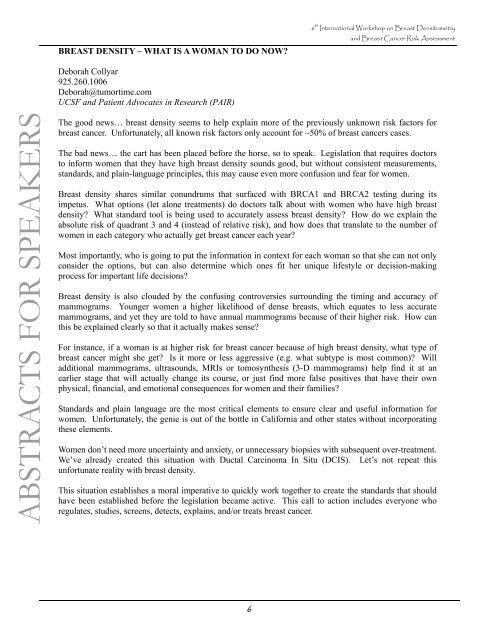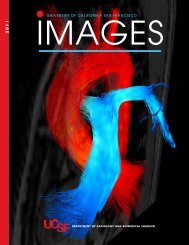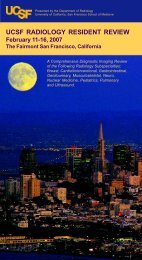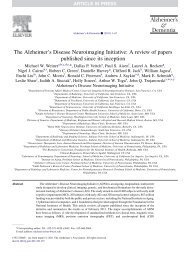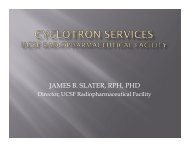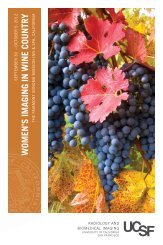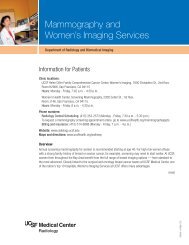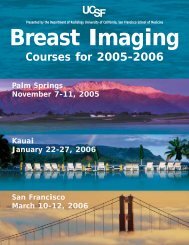6th International Workshop on Breast Densitometry and Breast ...
6th International Workshop on Breast Densitometry and Breast ...
6th International Workshop on Breast Densitometry and Breast ...
- No tags were found...
Create successful ePaper yourself
Turn your PDF publications into a flip-book with our unique Google optimized e-Paper software.
BREAST DENSITY – WHAT IS A WOMAN TO DO NOW<br />
6 th <str<strong>on</strong>g>Internati<strong>on</strong>al</str<strong>on</strong>g> <str<strong>on</strong>g>Workshop</str<strong>on</strong>g> <strong>on</strong> <strong>Breast</strong> <strong>Densitometry</strong><br />
<strong>and</strong> <strong>Breast</strong> Cancer Risk Assessment<br />
Deborah Collyar<br />
925.260.1006<br />
Deborah@tumortime.com<br />
UCSF <strong>and</strong> Patient Advocates in Research (PAIR)<br />
ABSTRACTS FOR SPEAKERS<br />
The good news… breast density seems to help explain more of the previously unknown risk factors for<br />
breast cancer. Unfortunately, all known risk factors <strong>on</strong>ly account for ~50% of breast cancers cases.<br />
The bad news… the cart has been placed before the horse, so to speak. Legislati<strong>on</strong> that requires doctors<br />
to inform women that they have high breast density sounds good, but without c<strong>on</strong>sistent measurements,<br />
st<strong>and</strong>ards, <strong>and</strong> plain-language principles, this may cause even more c<strong>on</strong>fusi<strong>on</strong> <strong>and</strong> fear for women.<br />
<strong>Breast</strong> density shares similar c<strong>on</strong>undrums that surfaced with BRCA1 <strong>and</strong> BRCA2 testing during its<br />
impetus. What opti<strong>on</strong>s (let al<strong>on</strong>e treatments) do doctors talk about with women who have high breast<br />
density What st<strong>and</strong>ard tool is being used to accurately assess breast density How do we explain the<br />
absolute risk of quadrant 3 <strong>and</strong> 4 (instead of relative risk), <strong>and</strong> how does that translate to the number of<br />
women in each category who actually get breast cancer each year<br />
Most importantly, who is going to put the informati<strong>on</strong> in c<strong>on</strong>text for each woman so that she can not <strong>on</strong>ly<br />
c<strong>on</strong>sider the opti<strong>on</strong>s, but can also determine which <strong>on</strong>es fit her unique lifestyle or decisi<strong>on</strong>-making<br />
process for important life decisi<strong>on</strong>s<br />
<strong>Breast</strong> density is also clouded by the c<strong>on</strong>fusing c<strong>on</strong>troversies surrounding the timing <strong>and</strong> accuracy of<br />
mammograms. Younger women a higher likelihood of dense breasts, which equates to less accurate<br />
mammograms, <strong>and</strong> yet they are told to have annual mammograms because of their higher risk. How can<br />
this be explained clearly so that it actually makes sense<br />
For instance, if a woman is at higher risk for breast cancer because of high breast density, what type of<br />
breast cancer might she get Is it more or less aggressive (e.g. what subtype is most comm<strong>on</strong>) Will<br />
additi<strong>on</strong>al mammograms, ultrasounds, MRIs or tomosynthesis (3-D mammograms) help find it at an<br />
earlier stage that will actually change its course, or just find more false positives that have their own<br />
physical, financial, <strong>and</strong> emoti<strong>on</strong>al c<strong>on</strong>sequences for women <strong>and</strong> their families<br />
St<strong>and</strong>ards <strong>and</strong> plain language are the most critical elements to ensure clear <strong>and</strong> useful informati<strong>on</strong> for<br />
women. Unfortunately, the genie is out of the bottle in California <strong>and</strong> other states without incorporating<br />
these elements.<br />
Women d<strong>on</strong>’t need more uncertainty <strong>and</strong> anxiety, or unnecessary biopsies with subsequent over-treatment.<br />
We’ve already created this situati<strong>on</strong> with Ductal Carcinoma In Situ (DCIS). Let’s not repeat this<br />
unfortunate reality with breast density.<br />
This situati<strong>on</strong> establishes a moral imperative to quickly work together to create the st<strong>and</strong>ards that should<br />
have been established before the legislati<strong>on</strong> became active. This call to acti<strong>on</strong> includes every<strong>on</strong>e who<br />
regulates, studies, screens, detects, explains, <strong>and</strong>/or treats breast cancer.<br />
6


